Electronic correlation effects observed in compounds formed by transition metals carrying itinerant d electrons and rare-earth (RE) metals with more localized f electrons are one of the central topics in solid-state chemistry and physics. These effects give rise to unusual behaviors, such as mixed and intermediate valence states, heavy fermion and non-Fermi liquid behaviors, superconductivity, Kondo insulators, Kondo semiconductors, quantum criticality, etc. Here we give a short overview of a selection of compounds which have been recently studied.
Skutterudites and related phases based on a platinum-germanium framework
Intermetallic compounds with a crystal structure composed of rigid covalently bonded cage-forming frameworks enclosing differently bonded guest atoms are of special interest and the filled-skutterudite compounds with common formula MT4X12 (Fig. 1) (where M = rare-earth or alkaline-earth metals, T = Fe, Ru, Pt, Os, and X = Ge, P, As, Sb) belong to this series. The filled skutterudite compound CePt4Ge12 is situated close to the border between the intermediate valence of Ce and heavy-fermion behavior. Substitution of Ge by Sb drives the system into a strongly correlated and, ultimately, upon further increasing the Sb concentration, an antiferromagnetically ordered state (AFM). Our experiments evidence a delicate interplay of emerging Kondo physics and the formation of a local 4f moment. An extended non-Fermi-liquid region, which can be understood in the framework of a Kondo-disorder model, is observed. Band-structure calculations support the conclusion that the physical properties are governed by the interplay of electron supply via Sb substitution and the concomitant volume effects (Fig. 2).
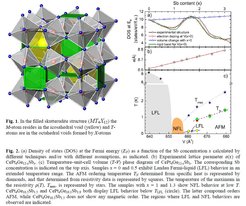
Particular attention has been paid to superconductivity observed in the Pr-based skutterudites. Among all the Pr-filled variants, PrPt4Ge12 shows an unexpectedly high transition temperature of Tc = 7.9 K. Measurements of the London penetration depth Δλ(T) (Fig. 3) and the electronic specific heat Ce(T) (Fig. 4) on high-quality single crystals of PrPt4Ge12 have been performed in collaboration with the partner group of Prof. H.Q. Yuan (http://www.css.zju.edu.cn/english/)). Both quantities show a weak temperature dependence at T << Tc, following, Δλ ∼ T n (n = 3.2 ± 0.1) and Ce/T ∼ T 2.8. Such temperature dependences deviate from both conventional s-wave-type and nodal superconductivity. A detailed analysis indicates that the superfluid density ρs (T ), derived from the penetration depth, as well as the electronic specific heat can be consistently described in terms of a two-gap model, providing strong evidence of multiband superconductivity for PrPt4Ge12.
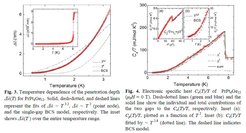
A combined study of the electronic structure of the superconducting filled skutterudite SrPt4Ge12 by means of X-ray photoelectron spectroscopy and full-potential band structure calculations (Fig. 5) including an analysis of the chemical bonding was performed in a joint effort with the department of Physics of Correlated Matter and showed excellent agreement between experiment and theory. The states at the Fermi level in SrPt4Ge12 originate predominantly from the Ge 4p electrons (Fig. 6) while the Pt 5d shell is effectively full (Fig. 7). All these findings validate that band structure calculations in combination with photoelectron spectroscopy can provide a solid basis for the modeling of superconductivity in the compound series MPt4Ge12 (M=Sr, Ba, La, Pr).
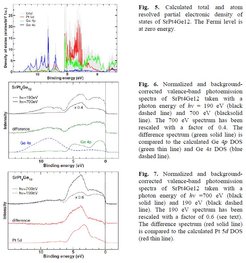
Another skutterudite related type of cage compounds crystallizes with the Pr3Rh4Sn13 type of structure and its derivatives. The intermetallic compound Y3Pt4Ge13 has been synthesized by high-pressure high-temperature technique (“High-pressure crystal chemistry”). It crystalizes with its own non-centrosymmetric type of crystal structure in the monoclinic space group Cc. Y3Pt4Ge13 is superconducting below Tc = 4.5 K. Thermodynamic properties as well as transport measurements were performed down to 0.4 K. The upper critical field is μ0Hc2 = 3.8 T, the lower one only μ0Hc1 = 5 mT. All observations are consistent with an s-wave symmetry single-energy gap for the superconducting phase (Fig. 8).

YbPtGe2: A multivalent charge-ordered system with an unusual spin pseudogap
Together with the department of Physics of Quantum Materials we performed a study of the structural and physical properties of YbPtGe2. This compound is a multivalent charge-ordered system presenting an unusual spin pseudogap below 200 K. The crystal structure of YbPtGe2 is refined from single-crystal and powder high-resolution synchrotron x-ray diffraction data at different temperatures. Analysis of the structural features of YbPtGe2, together with a combined study of Yb LIII x-ray absorption spectroscopy (Fig. 11), magnetic susceptibility χ(T ), thermopower S(T ), and 171Yb (Fig. 12) and 195Pt NMR indicate half of the Yb atoms to be in an intermediate valence state with an electronic configuration close to 4f 13 (Yb3+), while for the remaining Yb atoms the 4f 14 (Yb2+) configuration with almost no valence fluctuations is most likely. A drastic drop of the magnetic susceptibility and a decrease of the isotropic shift 195Kiso(T ) with decreasing temperature in the temperature range of 50–200 K evidence the opening of a spin pseudogap with an activation energy of Δ/kB ∼ 200 K. Surprisingly, transport properties do not show clear evidence for the opening of a charge gap, thus excluding a standard Kondo-insulator scenario. Possible origins for this unusual electronic (valence) behavior are discussed.
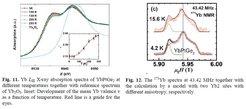
Superconductivity induced by Ru substitution in SrFe2-xRuxAs2
The magnetism in SrFe2As2 can be suppressed by electron doping through a small substitution of Fe by Co or Ni, giving way to superconductivity. We demonstrate that a massive substitution of Fe by isovalent ruthenium similarly suppresses the magnetic ordering in SrFe2−xRuxAs2 and leads to bulk superconductivity for 0.6 < x < 0.8 (Fig. 9). Magnetization, electrical resistivity, and specific-heat data show Tc up to ≈ 20 K. Detailed structural investigations reveal a strong decrease in the lattice parameter ratio c/a with increasing x. Density functional theory band-structure calculations are in line with the observation that the magnetic order in SrFe2−xRuxAs2 is only destabilized for large x (Fig. 10).
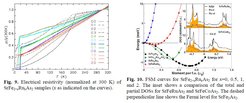
Phys Rev B 79, 214516 (2009)





